* Titles and affiliations are as of the time of the conference.
Presented at Third International Conference of Child Research Network Asia (CRNA) held in Jakarta, Indonesia, September 25-27, 2019.
STEAM in Early Childhood Education (ECE) in Malaysia
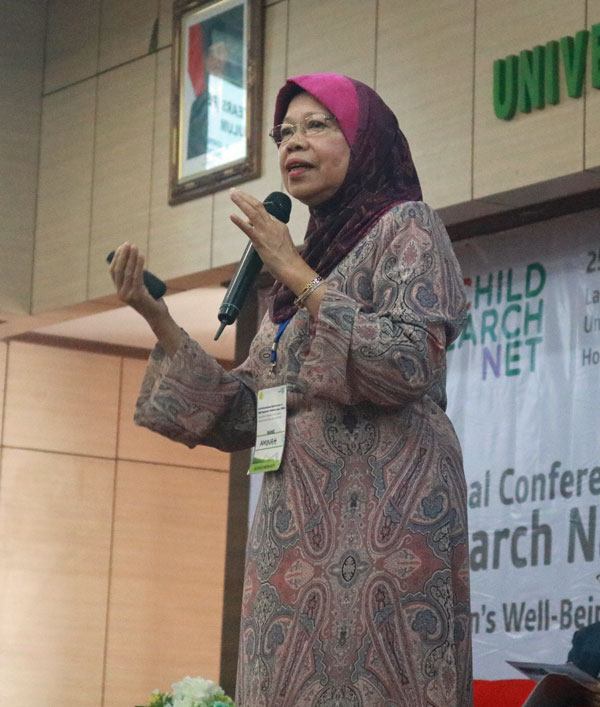
Thank you for allowing me to share with you my research done in Malaysia in 2015. My slides show the results of a pilot study carried out by staff researchers at my university, working to develop the early childhood education program called PERMATA. By 2025, the curriculum will have been completely revamped, to emphasize all the skills of effective communication; Environmental awareness, ICT & STEM/STEAM education even in preschool. I should explain now about STEM and STEAM. STEM stands for Science, Technology, Engineering and Mathematics, but it is not a mere acronym, more a single holistic integrated subject. If we then include Art it becomes STEAM, and the integration of these subjects can help students develop relevant knowledge, concepts and skills as wholesome individuals. The Ministry of Education in Malaysia is now putting emphasis on STREAM with the R standing for Reading or Religion. STEAM education is important in the 21st century because technological skills are not enough, we also need a humanitarian aspect.
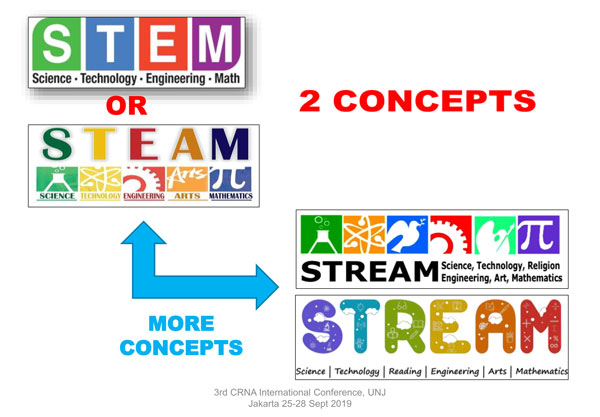
Our pilot study aims to answer the following 4 research questions:
- Is it feasible, possible, or suitable to implement STEM STEAM in early childhood curriculum, primarily the PERMATA curriculum?
- Is it feasible to implement STEM/STEAM to children age 3-4 years old?
- What are the effects of STEM/STEAM education on the ability to inquire, explore, invent and reflect, alongside the interest, communication and cooperation among 3 to 4 year-old children who are involved in the study?
- What are the effects of in-service STEM STEAM training on early childhood teachers' self-perceived pedagogical knowledge, skills and attitudes?
Theoretical Framework
In 2013 the National Research Council found that an increasing number of jobs require STEM/STEAM skills. The addition of STEAM learning brought human values to science and technological innovation. In early childhood, an appropriate STEM curriculum motivates children to seek mastery of basic academic and intellectual skills, such as reasoning, hypothesizing, predicting, and analysis of ideas. Through merging the pedagogy of early childhood education PERMATA Curriculum, which is play-based learning through the 3E (explore, experiment and experience), and STEAM (project-based learning) we can explore the 3E concept further through inquiry and 3C (collaborate, create, and communicate). For example, if children play with water, do they explore water, experiment with water, experience water flow, find water makes them wet? Do they realize they cannot catch water? We want them not to just experiment, but to experience it hands-on.
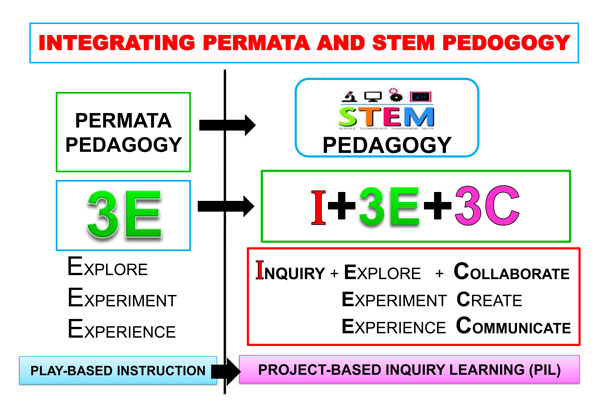
So here I will introduce the four phases of the project-based inquiry learning (PIL) approach: inquiry, exploration (experiment), invention (design and develop a product) and reflection. In the first phase children ask questions and based on those questions they make two inquiry maps, one is what we already know about the subject and the other is what we want to know. In the exploration phase, the teacher and student explore the idea or the concept through experiments, etc. From what they've learned, they shift to the invention phase. If they were playing with water, for example, dissolve tea or coffee in hot water. When making coffee, why does the water turn black? Water dissolves certain things. By using simple language like "mix," rather than "dissolve," they understand. You can use a lot of things from the kitchen to show children how to make mixtures of color. Then at the reflection stage they will talk about products, for example, how to filter water, or how to filter tea, so they will start thinking to solve the problem.
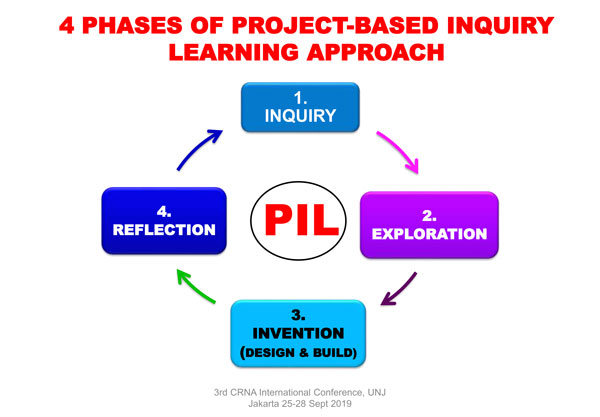
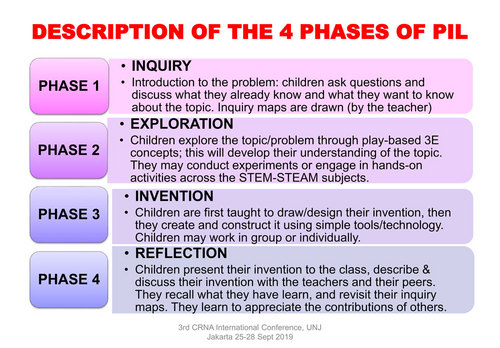
Now I will talk about how the modules were developed. First, we look at the curriculum. Of course, phase one is the inquiry. We have to teach them how to ask a full question, because they do not have the linguistic skill, but they may be able to form part of it. You should not expect them to have the ability, because they are not taught to speak full sentences at home. Usually, in one or two words, or split words. What happened to this water? Where does it go? The teacher re-phrases children's idea into a question or sentence. So, when we identify the science concept and skill in the curriculum, we identify the next language art skill in the curriculum and we put it together with the technological tool that we need and therefore we develop the project, and the module. And we, as teachers will use the module and so the experiment is carried out. Children will make connections and come up with inventions and so that is why the module is simple.
There are10 modules in the book of STEM/STEAM developed by the Research Team:
| Project 1 | Rubber-Band Powered Car |
| Project 2 | 3R (Reduce, Reuse, Recycle) |
| Project 3 | Terrarium |
| Project 4 | Tie and Dye |
| Project 5 | Composting |
| Project 6 | Umbrella |
| Project 7 | Chicken and Eggs |
| Project 8 | My Ship |
| Project 9 | Paper Making |
| Project 10 | Catapult |
A complete module set means there is a learning outcome and steps on how to conduct these activities, such as the four stages mentioned earlier. In this research we did pretests and posttests to consider the effect on the children . We also held a 3-day comprehensive workshop for teacher training and validation of 12 developmentally appropriate STEM Projects/Modules.
METHODOLOGY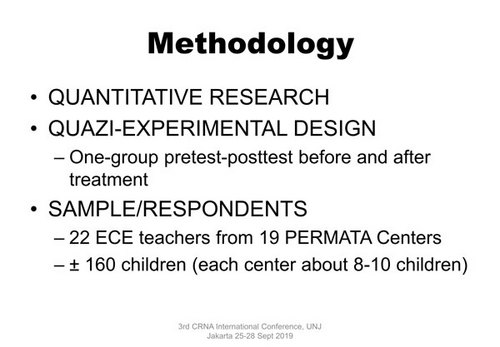
The sample of the research consisted of 22 ECE teachers and approximately 160 children from 19 PERMATA Centers.
FINDINGSAs for the effect on children, Inquiry, Exploration, Invention and Reflection skills all showed improvement, with Inquiry the lowest mainly because 3-4 year old children have not yet fully developed question-formation skills.
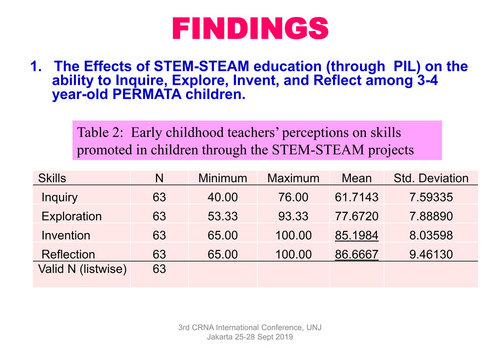
The effect on the ability to communicate and cooperate was also positive. Teachers were also positive about their ability to integrate STEM, particularly in the Permata curriculum. It is therefore feasible to integrate STEM to PERMATA curriculum and also feasible to have 3-4 year-olds learn from STEAM and STEM education.
For example, children see cars near their school and then explore toy cars. They make inquiry maps of what they know and what they want to know. Then comes the exploration phase; children play with toy cars, learn the names of parts of the car, how many passengers and so on. They learn about concepts like left right, front back, up down, wheels, number plates, and mathematics. When they create a drawing it is art. Thus, art, science and math are combined in a project, not separated. Show the meters in the car; the shape of the steering wheel; the shape of the wheels. What is a signal light, how many signals are there? Singing songs about cars. Pretend role-playing riding in a car. They can also learn about the properties of materials like rubber bands, elasticity. At the Invention stage, they discuss what to do, design their car, collect materials to make the wheels and so on. Using waste materials means the project is inexpensive. Learning to use tools, to cut plastic bottles/juice box, coloring them, tying rubber bands, fix the wheels, using an old CD to make the wheels, etc. (with the help of the teacher). What other things can be used for wheels? Children also count and measure the parts of their toy cars and test their products (technology). We soon find that children are very inventive in creating products.
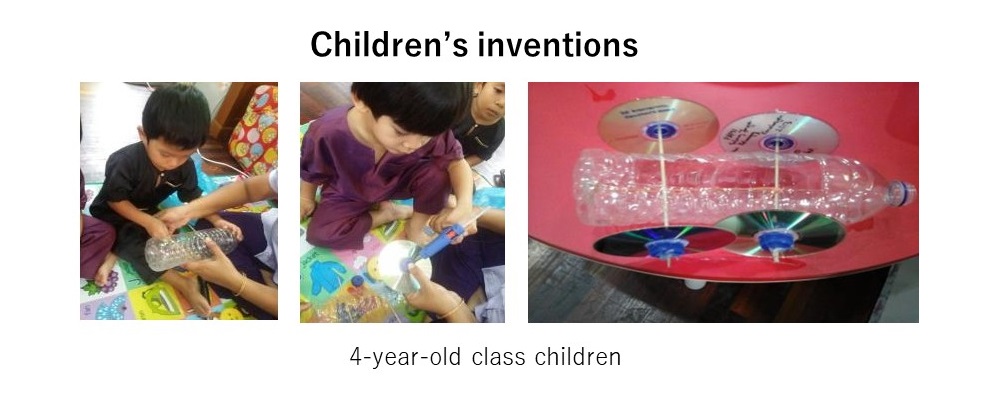
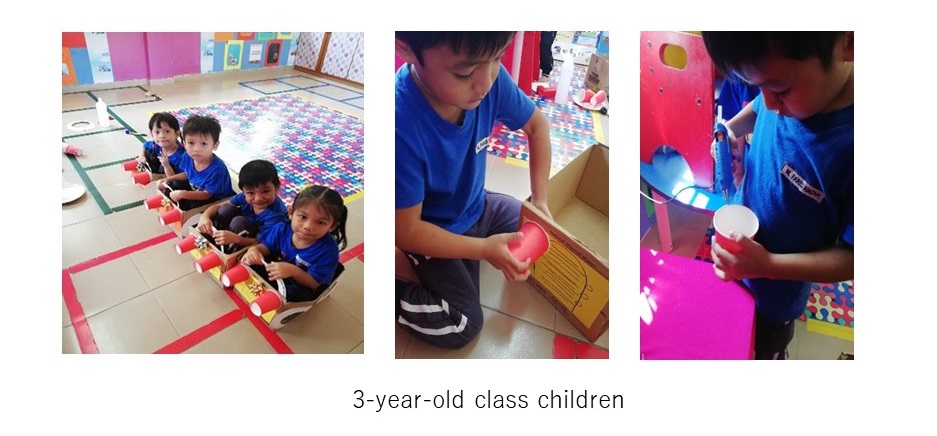
At the reflection stage they talk about it, share the experience with their teacher, ask how they can make it again next time.
The research can be summarized as follows:
- Teachers reported that training helped them understand about STEM-STEAM and developed their confidence in teaching it to PERMATA children.
- Children aged 3 to 4 years are ready to learn STEM-STEAM.
- The STEM-STEAM modules highly promoted the skills of Invention (86%) and Reflection (86%). while the skills of Inquiry and Exploration were averagely promoted.
- In this study, both the teachers and children were excited and felt a sense of accomplishment after the project.
- The children and the teachers too reported that they learned a lot about STEM-STEAM education through this pilot project, and would like to be more involved in the future.
- Teachers agreed that it was easy to integrate STEM -STEAM education into the existing PERMATA curriculum.
- Teachers requested more training to develop their own STEM modules (from an open-ended question in the teachers' questionnaire).
Conclusion
Use the opportunity for them to explore more and understand concepts that exist in the children's surroundings.
- Children, as young as 3-4 years old are capable of learning STEM-STEAM if given the opportunity;
- The 4-phase PIL pedagogy (inquiry, exploration, invention and reflection) used in the study is considered most suitable for teaching STEM-STEAM to young children.
- STEM-STEAM education is already there in the ECE curriculum, it is up to the teacher to uncover and make use of it.
- STEM-STEAM is not a subject, but a tool to advance the holistic development of children through meaningful experiences.
Suggestions:
- Need policy for integration of STEM-STEAM into national curriculum.
- Set up STEM-STEAM Committee to promote and coordinate the implementation across all ECE providers.
- Set up training centers for STEM-STEAM training and professional development.
- Need to conduct more research and collect data on STEM-STEAM initiatives and talents among students and teachers.
- Government needs to increase investment in STEM-STEAM education at all levels of schooling.
- Need to increase advocacy partnerships with major industrial players in the country for supporting STEM-STEAM learning in schools and preschools.
Q&A
Q1: I am interested in STEM, and have done two researches in elementary school, grade 3 and 4 and teachers. As you say, implementing STEM gives positive effects for children, and it should also be implemented for teachers of ECE and elementary school.
My question is, how to integrate the engineering step into early childhood or kindergartens. Any examples in implementing STEM in early childhood?
A1: Actually, engineering at the lower level concerns designing and building. The art focuses on the artistic values of design, such as colors and decoration. If a child wants to build a house, for example a chicken coop, one of the projects would be learning about the life-cycle of chicken and about eggs. Children have never seen the feathers of chickens, or know how many feet a chicken has. So, you have to show them a video of chicken laying eggs. When they design, they have to add some decoration, or colors to it. It's not necessarily engineering but there's art there. So, it is not a high level of engineering, as one would imagine, but that is enough for children to start at this level.
Q2: Children don't know how to ask a good question since they are not used to asking questions. How can we promote children to ask more questions and any tips for implementing?
A2: Of course, it's not as smooth. The teachers reported it is so hard to coax the children, and stimulate the students to ask questions. They might not even be in a sentence, but it can be framed into a question. Slowly we can train them. First, you ask the children, "do you want to know about this?", then the children say yes or no. Rephrase the question for them, so they can answer. "Do you want to know whether the chicken lives in a tree or in a chicken coop?" In the villages, some chickens live in the tree, but in other places they build coops for the chicken.
These are some of the obstacles. Even though children don't know how to read or write, they can listen and understand words. We can always talk to them with questions. Literacy does not really have to be from reading or writing. Our environment today is very rich. Don't worry. This is what teaching is. Guide them.
Q3: How do you disseminate, share with others about the program?
A3: Of course, especially among the private sectors, parents are now aware of the importance of ECEC. Parents need to keep on talking. The word of mouth of parents is very important. Parents would want to choose to send their children to kindergartens that do modern STEM education. That's how we disseminate it.



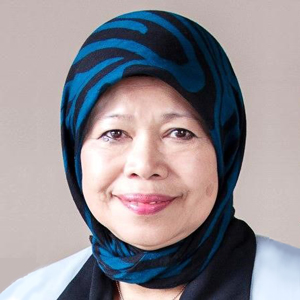 Aminah Ayob
Aminah Ayob










